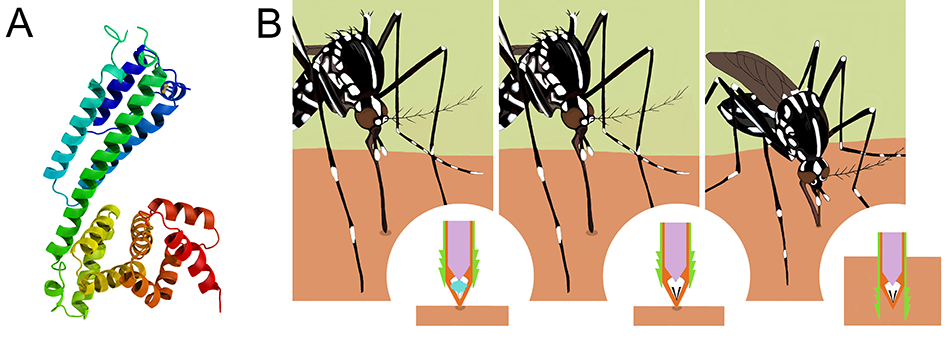Research Topics:
Signaling in Insects
We established a strong collabration with the Laboratory of Insect Evolutionary Molecular Biology to investigate insect chemoreception and signaling at the biochemical and structural level. Our methods for recombinant protein production proved highly suitable for these investigations and we are currently exploring how the broad diversity in protein sequences and architectures correlates with specific insect physiological functions.
In this context, Aedes albopictus LIPS-2 was identified as a salivary factor controlling probing in Aedes mosquitoes prior to blood feeding. We carried out a comprehensive and multidisciplinary investigation around this protein, including its three-dimensional structure which revealed a novel fold (figure A). This characterization ultimately yielded a model of the role of LIPS-2 during blood feeding. In this model mosquitoes start salivating when they press the proboscis on the skin surface (figure B, left panel), since the saliva is deposited on the surface of the membrane during bite-blot experiments. LIPS-2 in the saliva binds the CP19 at the tip of the labrum and this causes a change in the morphology of the V-shaped ridges, enhancing their depth (figure B, central panel). Finally, this change is sensed by mosquitoes, and it causes further salivation and the beginning of the intradermal probing (figure B, right panel), facilitating blood vessel location. The labrum is shown in orange, the hypopharynx carrying the salivary duct and its opening at the tip in violet, maxillae in green. The V-shaped ridges are shown as black line after stimulation.

PDB Files:
SASBDB Files:
Raw Data in Repository:
Files in Repository:
Publications:
IgE response to Aed al 13 and Aed al 14 recombinant allergens from Aedes albopictus saliva in humans
World Allergy Organization Journal, 16, 100836. (2023) -
PubMed
-
Arnoldi I., Mancini G., Fumagalli M., Gastaldi D., D"Andrea L., Bandi C., Di Venere M., Iadarola P., Forneris F., Gabrieli P.
A salivary factor binds a cuticular protein and modulates biting by inducing morphological changes in the mosquito labrum
Current Biology, 32, 1-12. (2022) - PubMed
-
Buezo Montero S, Gabrieli P, Montarsi F, Borean A, Capelli S, De Silvestro G, Forneris F, Pombi M, Breda A, Capelli G, Arcà B.
IgG Antibody Responses to the Aedes albopictus 34k2 Salivary Protein as Novel Candidate Marker of Human Exposure to the Tiger Mosquito
Frontiers in Cellular and Infection Microbiology, 10, 377. (2020) - PubMed
-
Buezo Montero S, Gabrieli P, Severini F, Picci L, Di Luca M, Forneris F, Facchinelli L, Ponzi M, Lombardo F, Arcà B.
Analysis in a murine model points to IgG responses against the 34k2 salivary proteins from Aedes albopictus and Aedes aegypti as novel promising candidate markers of host exposure to Aedes mosquitoes.
PLoS Neglected Tropical Diseases, 13, e0007806. (2019) - PubMed
-
Falchetto M*, Ciossani G*, Scolari F, Di Cosimo A, Nenci S, Field LM, Mattevi A, Zhou J-J, Gasperi G**, Forneris F**
Structural and biochemical evaluation of Ceratitis capitata OBP22 affinity for odorants involved in inter-sex communication.
Insect Molecular Biology, 28, 431-443. (2018) *Equal Contribution - **Shared Corresponding Authors - PubMed
Press releases (in Italian):
Highlights from the media: Newspapers Articles (in Italian, see more in the Outreach Section):
Active Grants related to this research:
![]() NextGenerationEU Program - National Reprise and Resilience Plan (PNRR), Partenariato Esteso Malattie Infettive Emergenti - INF-ACT Foundation
NextGenerationEU Program - National Reprise and Resilience Plan (PNRR), Partenariato Esteso Malattie Infettive Emergenti - INF-ACT Foundation
Completed Grants related to this research:
